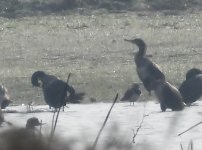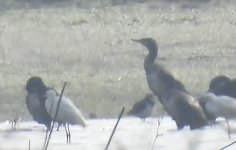Hi, the wader (or possibly a duck?) in the attached 2 photos puzzle me. The photos were taken in the Phewa Lake wetlands, just outside Pokhara, Nepal (central Nepal) on Nov 28, 2023. The area is one of rice fields with a few creeks or natural "canals" running through it with some reeds.
The Great Cormorants give an idea of its size. None of the expected ducks have that kind of a breast or neck band I believe, so I think that leaves a wader. But it does seem large and plump, more duck like than wader.
But the only expected "waders" that occour there that have that sort of breast band are, I believe, Northern Lapwing and Green Sandpiper. However, I have no experience with Northern Lapwings, though its stance is more like a lapwin I think than a sandpiper. Or perhaps it is a Ruff? I clearly have no idea
There is, I think, a Goosander making an appearance in the lower left of photo 1 and 2 little egrets in the second photo.
Any comments, criticism or advice on the ID of this rather plump bird, if such is possible with such a poor photo, would be much appreciated.
thank you in advance
steve
The Great Cormorants give an idea of its size. None of the expected ducks have that kind of a breast or neck band I believe, so I think that leaves a wader. But it does seem large and plump, more duck like than wader.
But the only expected "waders" that occour there that have that sort of breast band are, I believe, Northern Lapwing and Green Sandpiper. However, I have no experience with Northern Lapwings, though its stance is more like a lapwin I think than a sandpiper. Or perhaps it is a Ruff? I clearly have no idea
There is, I think, a Goosander making an appearance in the lower left of photo 1 and 2 little egrets in the second photo.
Any comments, criticism or advice on the ID of this rather plump bird, if such is possible with such a poor photo, would be much appreciated.
thank you in advance
steve








